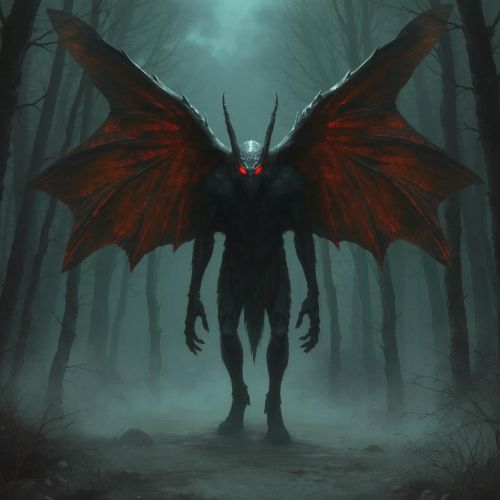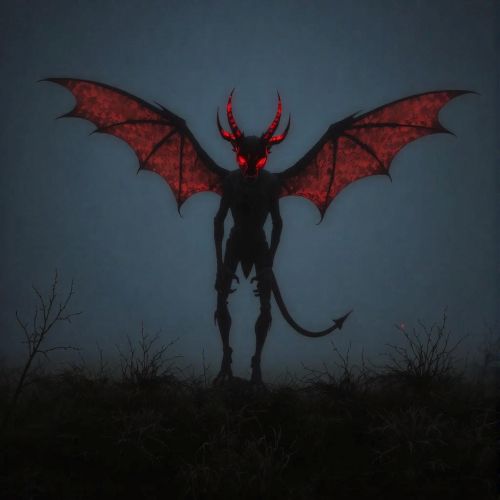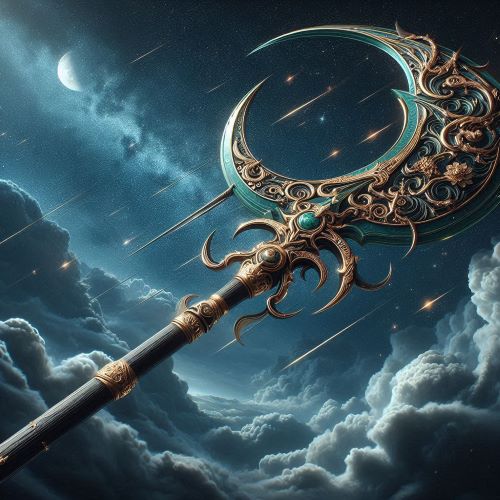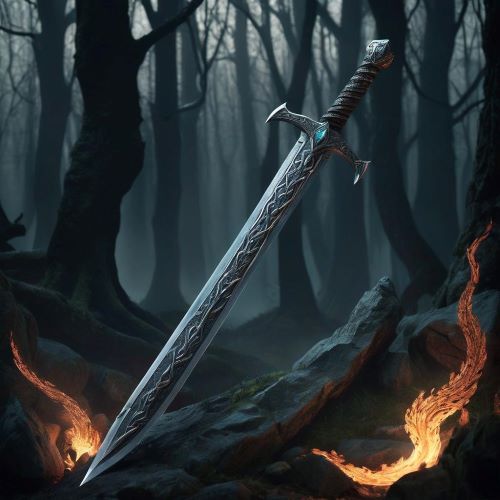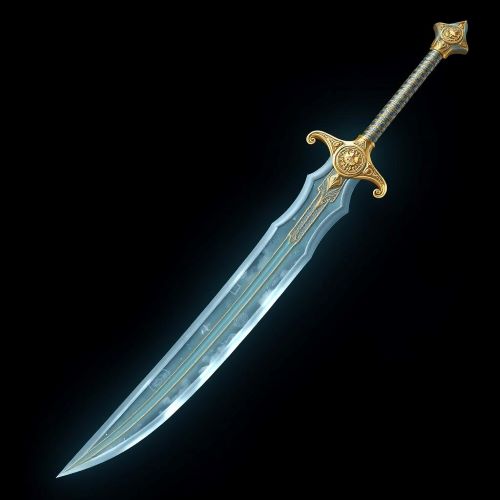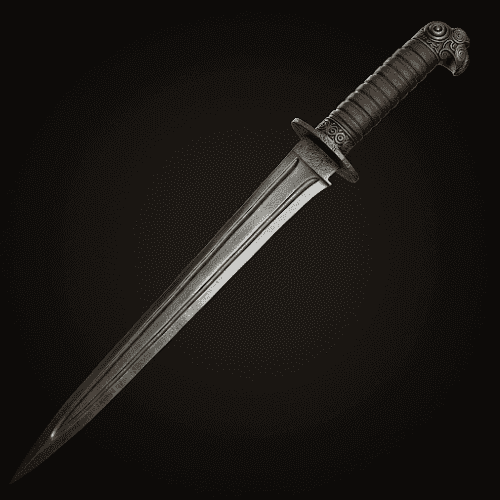Shamshir-e-Zomorrodnegar : The Emerald Blade
Shamshir-e-Zomorrodnegar
Introduction
The Shamshir-e-Zomorrodnegar, or Emerald-Studded Sword, stands as a legendary weapon in Iranian mythology, celebrated for its extraordinary qualities and rich historical significance. It plays a prominent role in Persian literature, especially within the epic verses of the Shahnameh and the stories of Amir Arsalan. More than just a weapon, it embodies Persia’s martial heritage and highlights the cultural importance of swordsmanship throughout Iranian history. This remarkable artifact is a testament to divine craftsmanship and unmatched power, captivating the imaginations of many across generations and borders. Its legacy is woven into the very fabric of Iran’s mythological and cultural narratives.
Origins
The origins of the Shamshir-e-Zomorrodnegar, or Emerald-Studded Sword, are steeped in ancient myths and legends. One widely shared tale attributes its creation to the legendary blacksmith Kaveh, who is said to have forged the blade from the heart of a celestial dragon. This mythical dragon’s blood, infused with cosmic energy, bestowed the sword with remarkable properties and formidable strength.
Another narrative suggests that the sword was a divine gift, granted to a chosen hero as a token of their destined path. Its emerald hilt and blade were believed to radiate an ethereal glow, symbolizing the purity and righteousness of its bearer. The term “Shamshir-e-Zomorrodnegar” translates to “The Emerald-Studded Sword,” aptly capturing its majestic appearance. This sword, associated with Kaveh, represents not only a weapon but also a profound symbol of resistance against tyranny, showcasing the cultural values celebrated in Persian heritage. Kaveh’s story emphasizes the importance of craftsmanship and artistry, as he is often portrayed as a figure of rebellion against oppression. The forging of the sword reflects a struggle for justice and the heroic spirit cherished in Persian narratives.
The connection to figures like Prince Milad highlights themes of nobility and valor, intertwining the sword with ideals of heroism prevalent in Persian literature. Additionally, linking the sword to King Solomon—renowned for his wisdom and justice—enhances its mythological status. This association imbues the Shamshir-e-Zomorrodnegar with not only physical strength but also intellectual attributes, reflecting the dual nature often found in legendary artifacts.
The craftsmanship of the sword is described as masterful, underscoring the high skill involved in its creation. It transcends its role as a mere weapon, emerging as a work of art. The emerald-studded hilt signifies luxury and beauty, making the sword a coveted object for both noble heroes and ambitious villains alike.
Throughout the ages, the Shamshir-e-Zomorrodnegar has woven itself into the fabric of Persian folklore. Its narrative evolves with each retelling, enriching the cultural tapestry of Iran. These stories often convey moral lessons or reflect historical struggles against oppression, solidifying the sword’s status as a potent emblem. Beyond personal heroism, it represents a collective cultural identity, linking the past with the present through its enduring legacy.
Think you know your myths and legends? Dive into the world of ancient stories and test your knowledge with our engaging quizzes on Mythlok!
Powers
The Shamshir-e-Zomorrodnegar is a weapon of remarkable abilities, sought after by both heroes and villains. Among its most impressive powers is its unparalleled sharpness, enabling it to slice through any material, whether steel, stone, or even magical barriers, with extraordinary ease. In the hands of a righteous user, the sword possesses healing properties, allowing it to mend wounds and even restore life. It is said to cure diseases, reverse the effects of aging, and potentially bring the deceased back to life. Additionally, the sword can harness elemental forces, commanding fire, water, earth, and air. Its wielder can summon storms, create earthquakes, and influence the natural world around them.
The Shamshir-e-Zomorrodnegar also enhances the magical abilities of its bearer, amplifying spells, increasing resistance to magical attacks, and granting new powers. Furthermore, the sword offers divine protection, deflecting attacks, warding off evil spirits, and shielding its wielder from divine wrath. Notably, the emeralds embedded in the blade possess potent magical properties, neutralizing poisons and curses. This exceptional sharpness and the sword’s overall strength render it invaluable to true heroes. Its ability to nullify magic makes it a critical asset in conflicts against supernatural entities, underscoring its status as a protective talisman.
The sword’s magical powers are a result of the enchantments woven into its creation, reflecting the legendary skill of its maker, Kaveh the Blacksmith. Wielding the Shamshir-e-Zomorrodnegar confers a sense of invulnerability against most magical assaults, suggesting a close relationship between the sword and divine protection. Possessing the weapon symbolizes receiving favor from higher powers while confronting malevolent forces. However, the wounds inflicted by the Shamshir-e-Zomorrodnegar are unique; they are said to be unhealable by conventional means. This increases the sword’s lethality, as those struck incur injuries that require a special potion derived from the brain of Fulad-Zereh, a demon central to the sword’s lore.
This requirement intertwines the Shamshir-e-Zomorrodnegar with darker elements of Persian folklore, highlighting the complexities of magic and warfare. Fulad-Zereh, depicted as a grotesque horned demon, adds layers to the sword’s narrative, enriching the themes of sacrifice and the true nature of power within this mythology. The difficulty of obtaining the potion emphasizes the tragic elements of the stories associated with the sword, offering moral lessons about the consequences of wielding such extraordinary power.
Owners/Users
The Shamshir-e-Zomorrodnegar has a rich and varied history, having been wielded by several key figures in Iranian mythology. Its journey began with Prince Milad, whose heroic status was solidified through his association with the sword. After Milad’s tragic end, the weapon fell into the hands of Fulad-Zereh, a formidable horned demon. Enchanted by his mother, Fulad-Zereh became nearly invulnerable to all weapons except for the Shamshir-e-Zomorrodnegar.
One of the most celebrated stories involving the sword is the conflict between Fulad-Zereh and the hero Amir Arsalan. Entrusted with the mission to defeat the demon, Amir Arsalan acquires the Shamshir-e-Zomorrodnegar, ultimately using it to triumph over Fulad-Zereh. This victory not only restores peace but also cements Amir Arsalan’s legacy as a legendary figure in Persian mythology. The sword stands as a powerful symbol of justice, often held by noble heroes in their battles against tyranny.
The weapon has also been linked to several other legendary characters. Rostam, one of the most esteemed heroes in Persian lore, is frequently associated with the Shamshir-e-Zomorrodnegar. His tales often depict him using the sword to overcome formidable adversaries, including the legendary dragon Simorgh and the wicked sorceress Sorush. Another notable figure is Khosrow Parviz, a revered Persian king, who is said to have wielded the Shamshir-e-Zomorrodnegar in defense of his kingdom against invading forces. Additionally, Bahram Gur, another celebrated hero, reportedly used the sword to vanquish the evil demon Div.
The Shamshir-e-Zomorrodnegar’s legacy is further enriched by the stories of Esfandiyar, a heroic character from the Shahnameh, who also draws upon the sword’s formidable powers in his quests. Through these legendary figures, the sword not only embodies the ideals of courage and honor but also reinforces its significance in the cultural narrative of Iran.
Instances used
The Shamshir-e-Zomorrodnegar features prominently in several dramatic episodes within Iranian mythology, showcasing its formidable powers and the heroic deeds associated with it. A pivotal moment unfolds in the tale of Amir Arsalan, where he battles Fulad-Zereh, a demon who has usurped the throne and petrified the citizens of his kingdom. This climactic confrontation highlights the sword’s unique ability to negate the demon’s powerful magical defenses, ultimately leading to Fulad-Zereh’s downfall.
Another significant instance occurs in the **Shahnameh**, where the Shamshir-e-Zomorrodnegar inspires Persian warriors and instills dread in their foes. The mere presence of the sword on the battlefield serves as a beacon of hope for the warriors fighting under its banner, symbolizing their collective strength against overwhelming odds. The sword’s legacy is further reinforced through various cultural adaptations and retellings, reflecting its enduring impact on Iranian literature and folklore.
In contemporary interpretations, the Shamshir-e-Zomorrodnegar has found its way into various creative industries, influencing video games and films that depict its legendary feats and echo the tales of old. These modern adaptations bridge the gap between past and present, ensuring that the legend of the Shamshir-e-Zomorrodnegar resonates with new audiences worldwide.
Among its many notable appearances, one of the most poignant stories involves the tragic clash between Rostam and his son Sohrab. In this heart-wrenching tale, Rostam wields the Shamshir-e-Zomorrodnegar during their fateful encounter, yet he is unable to avert the disastrous consequences of their battle. Additionally, the sword is central to Bahram Gur’s victory over the Demon Div, showcasing how it empowers legendary heroes to protect their kingdoms. Khosrow Parviz also employs the Shamshir-e-Zomorrodnegar to defend his empire from invaders, further solidifying its status as a crucial weapon in the annals of Persian heroism.
The legendary sword’s remarkable attributes and its connection to pivotal events throughout Iranian mythology cement its position as a powerful symbol of divine intervention, justice, and heroic virtue. Its enduring presence in these narratives speaks to the cultural richness of ancient Iran and continues to inspire and captivate audiences today. Whether in the retelling of classic tales or in modern adaptations, the Shamshir-e-Zomorrodnegar stands as a testament to the timeless allure of myth and legend.
Frequently Asked Questions
Lorem ipsum dolor sit amet, consectetur adipiscing?
Lorem ipsum dolor sit amet, consectetur adipiscing elit. Praesent convallis vestibulum justo, ac tincidunt nunc vehicula quis. Nullam id dolor quis orci malesuada feugiat. Curabitur aliquet libero at urna ullamcorper, ac ultricies nulla dapibus.
Lorem ipsum dolor sit amet, consectetur adipiscing?
Lorem ipsum dolor sit amet, consectetur adipiscing elit. Praesent convallis vestibulum justo, ac tincidunt nunc vehicula quis. Nullam id dolor quis orci malesuada feugiat. Curabitur aliquet libero at urna ullamcorper, ac ultricies nulla dapibus.
Lorem ipsum dolor sit amet, consectetur adipiscing?
Lorem ipsum dolor sit amet, consectetur adipiscing elit. Praesent convallis vestibulum justo, ac tincidunt nunc vehicula quis. Nullam id dolor quis orci malesuada feugiat. Curabitur aliquet libero at urna ullamcorper, ac ultricies nulla dapibus.
Lorem ipsum dolor sit amet, consectetur adipiscing?
Lorem ipsum dolor sit amet, consectetur adipiscing elit. Praesent convallis vestibulum justo, ac tincidunt nunc vehicula quis. Nullam id dolor quis orci malesuada feugiat. Curabitur aliquet libero at urna ullamcorper, ac ultricies nulla dapibus.
Lorem ipsum dolor sit amet, consectetur adipiscing?
Lorem ipsum dolor sit amet, consectetur adipiscing elit. Praesent convallis vestibulum justo, ac tincidunt nunc vehicula quis. Nullam id dolor quis orci malesuada feugiat. Curabitur aliquet libero at urna ullamcorper, ac ultricies nulla dapibus.



